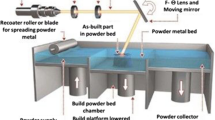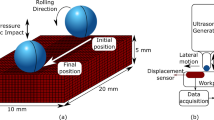Abstract
Large tensile residual stresses generated during cold working processes could negatively affect the integrity and geometric accuracy of workpieces. The stress relief annealing is one of the fundamental issues in controlling the deformation of the cold-worked part. A novel residual stress relaxation model was proposed to predict the change of residual stress during the annealing process by considering the dislocation evolution mechanism and the plasticity theory. Copper workpieces were rolled with different rolling ratios and annealed under different heating temperatures and heating times. Hole-drilling experiments were conducted to measure the residual stresses for calibrating the proposed model. The calibrated model was then used to predict the change of residual stresses during annealing heat treatment. The results showed that the initial work hardening of workpieces had a great effect on the residual stress relaxation. Higher initial dislocation density hindered the residual stress relaxation during the annealing process. The results provided guidance on optimizing the annealing conditions for residual stress reduction.











Similar content being viewed by others
References
K. Huang, W. Yang and X. Ye, International Journal of Mechanical Sciences, 2018, vol. 135, pp. 43-52.
W. Wang, H. Liu, C. Zhu, X. Du and J. Tang, International Journal of Mechanical Sciences, 2019, vol. 151, pp. 263-273.
C. Wang, C. Jiang and V. Ji, Journal of Materials Processing Technology, 2017, vol. 240, pp. 98-103.
B. J. Foss, S. Gray, M. C. Hardy, S. Stekovic, D. S. McPhail and B. A. Shollock, Acta Materialia, 2013, vol. 61(7), pp. 2548-2559.
Z. Wang, A. D. Stoica, D. Ma, A. M. Beese, Materials Science and Engineering: A, 2018, vol. 714, pp. 75-83.
J. Epp, H. Surm, T. Hirsch and F. Hoffmann, Journal of Materials Processing Technology, 2011, vol. 211(4), pp. 637-643.
I. Nikitin and M. Besel, Scripta Materialia, 2008, vol. 58(3), pp. 239-242.
V. P. Radchenko, M. N. Saushkin and V. V. Tsvetkov, Journal of Applied Mechanics and Technical Physics, 2016, vol. 57(3), pp. 559-568.
P. Dong, S. Song and J. Zhang, International Journal of Pressure Vessels and Piping, 2014, vol. 122, pp. 6-14.
L. A. Godlewski, X. Su, T. M. Pollock and J. E. Allison, Metallurgical and Materials Transactions A, 2013, vol. 44(10), pp. 4809-4818.
Z. Trojanová, P. Lukác and K. U. Kainer, Advanced Engineering Materials, 2007, vol. 9(5), pp. 370-374.
K. Sherafatnia, G. H. Farrahi and A. H. Mahmoudi, International Journal of Mechanical Sciences, 2018, vol. 137, pp. 171-181.
A. Madariaga, J. Aperribay, P. J. Arrazola, J. A. Esnaola, E. Hormaetxe, A. Garay and K. Ostolaza, Journal of Materials Engineering and Performance, 2017, vol. 26(8), pp. 3728-3738.
H. D. Chandler, Materials Science and Engineering: A, 2010, vol. 527(23), pp. 6219-6223.
B. Babu and L. E. Lindgren, International Journal of Plasticity, 2013, vol. 50, pp. 94-108.
H. Wang, B. Clausen, L. Capolungo, I. J. Beyerlein, J. Wang and C. N. Tome, International Journal of Plasticity, 2016, vol. 79, pp. 275-292.
D. J. Buchanan, R. John, R. A. Brockman and A. H. Rosenberger, JOM, 2010, vol. 62(1), pp. 75-79.
Y. C. Lin, X. M. Chen, D. X. Wen and M. S. Chen, Computational Materials Science, 2014, vol. 83, pp. 282-289.
F. Roters, D. Raabe and G. Gottstein, Acta Materialia, 2000, vol. 48(17), pp. 4181-4189.
W. Blum, P. Eisenlohr and F. Breutinger, Metallurgical and Materials Transactions A, 2002, vol. 33(2), pp. 291-303.
W. Blum and P. Eisenlohr, Materials Science and Engineering: A, 2009, vol. 510-511, pp. 7-13.
P. Eisenlohr and W. Blum, Materials Science and Engineering: A, 2005, vol. 400-401, pp. 175-181.
S. Rahimi, M. King and C. Dumont, Materials Science and Engineering: A, 2017, vol. 708, pp. 563-573.
S. D. Antolovich and R.W. Armstrong, Progress in Materials Science, 2014, vol. 59, pp. 1-160.
S. Curtze and V. T. Kuokkala, Acta Materialia, 2010, vol. 58, pp. 5129-5141.
H. J. Frost and M. F. Ashby, Deformation mechanism maps: the plasticity and creep of metals and ceramics. (Pergamon, Oxford, 1982).
X.G. Fan and H. Yang, International Journal of Plasticity, 2011, vol. 27(11), pp. 1833-1852.
D. Kuhlmann-Wilsdorf, Materials Science and Engineering: A, 1989, vol. 113, pp. 1-41.
U. F. Kocks and H. Mecking, Progress in Materials Science, 2003, vol. 48(3), pp. 171-273.
N. Bertin, L. Capolungo and I. J. Beyerlein, International Journal of Plasticity, 2013, vol. 49, pp. 119-144.
G. K. Williamson and R. E. Smallman, Philosopical Magazine, 1956, vol. 1(1), pp. 34-46.
G. K. Williamson and W. H. Hall, Acta Metallurgica, 1953, vol. 1, pp. 22-31.
M. Kazeminezhad, Materials Science and Engineering A, 2008, vol. 486, pp. 202–207.
L. Błaż and P. Kwapisiński, Archives of Metallurgy and Materials, 2009, vol. 54(1), pp. 161-170.
Acknowledgments
This study was supported by the Science Challenge Project (JCKY2016212A506-0101), the National Natural Science Foundation of China (51605077), the Fundamental Research Funds for the Central Universities (DUT18LAB18), and the Science Fund for Creative Research Groups of NSFC (51621064).
Author information
Authors and Affiliations
Corresponding author
Additional information
Publisher's Note
Springer Nature remains neutral with regard to jurisdictional claims in published maps and institutional affiliations.
Manuscript submitted Feburary 11, 2019.
Rights and permissions
About this article
Cite this article
Bai, Q., Feng, H., Si, LK. et al. A Novel Stress Relaxation Modeling for Predicting the Change of Residual Stress During Annealing Heat Treatment. Metall Mater Trans A 50, 5750–5759 (2019). https://doi.org/10.1007/s11661-019-05454-z
Received:
Published:
Issue Date:
DOI: https://doi.org/10.1007/s11661-019-05454-z




